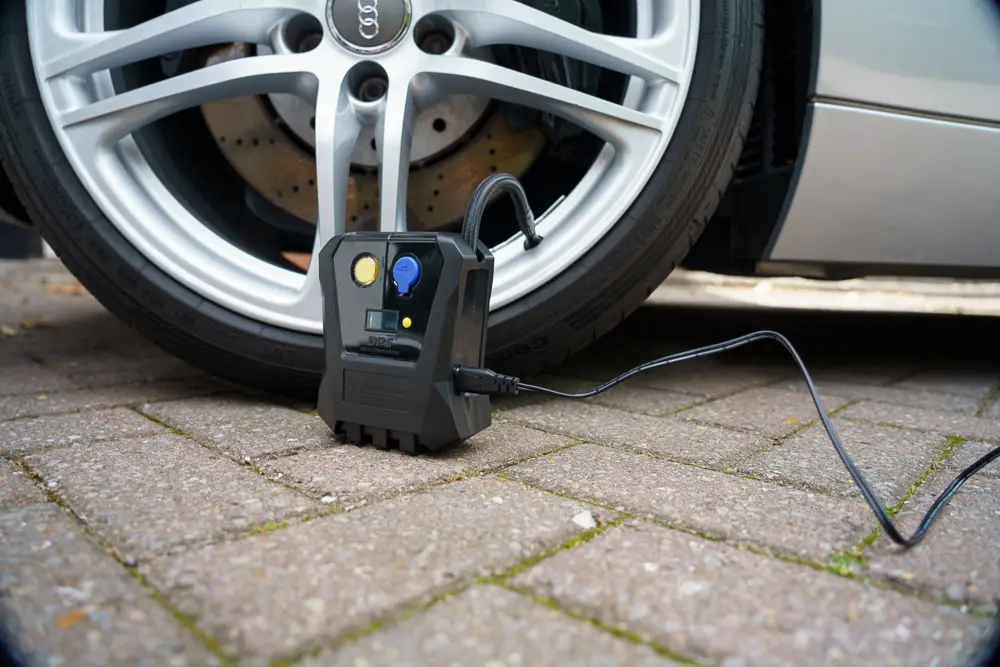Are you considering using nitrogen in your vehicle’s tires instead of compressed air? You’ve probably heard that nitrogen-filled tires stay inflated for extended periods of time, saving you money on gas and extending tread life. However, you’re concerned that you won’t always be able to find a nitrogen source. When your tires need to be topped off. Can you mix air and nitrogen in tires? We’ve done the research and can provide you with the answers!
Yes, you can inflate a tire that contains nitrogen. In truth, the air is made up of 78% nitrogen, 21% oxygen, and 1% other gases; therefore, adding air to nitrogen-filled tires will just dilute the pure nitrogen with a small quantity of oxygen. We’ll go over why it’s okay to mix air and nitrogen in your tires, as well as the disadvantages of doing so in this article.
We will also talk about whether nitrogen or compressed air is preferable for filling tires, as well as whether you can put nitrogen in your tires at home. We’ll also show you how to tell if your tires are nitrogen-filled. How long they should stay inflated, and how often you should check their pressure. Let’s get started without further ado!
- What is Nitrogen?
- Nitrogen Filled Tires
- Nitrogen Tires Better
- How can you Identify?
- Lifespan
- How to Inspect?
- Pros and cons?
What Exactly Is Nitrogen?
The periodic table’s seventh element is nitrogen. Nitrogen atoms are made up of seven protons, seven neutrons, and seven electrons in their most basic form. At sea level, molecular dinitrogen (N2) makes up 78% of the atmosphere, with dioxygen (O2) accounting for the remaining 21%.
Dr. Daniel Rutherford, a Scottish physician, was the first to isolate nitrogen from the air in 1772. Rutherford referred to it as “noxious air” since he didn’t identify it as a new chemical element. And remarking that it seemed “lifeless” because it could not maintain a flame.
Overview Of Nitrogen Filled Tires
Since the 1950s, nitrogen has been used to inflate jet aircraft tires. Pure nitrogen was first used to inflate tires in extreme motorsports such as top fuel, drag racing, and Formula One in 1992.
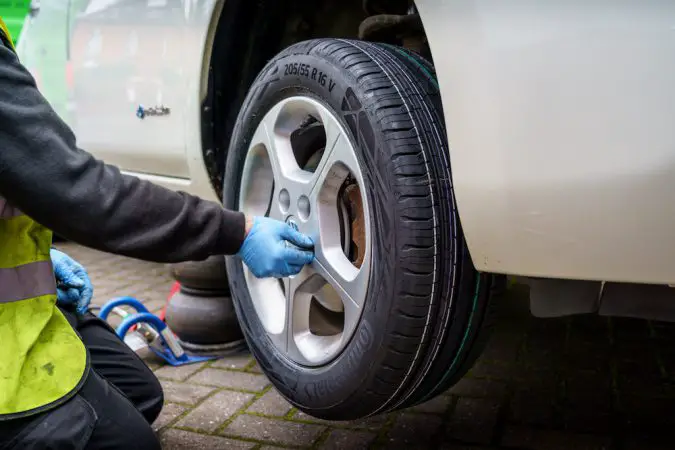
Nitrogen tire inflation was initially commercially available in 1999 through a chain of British superstores, and by 2007, it had become commonplace. The service was offered all across the world.
There are no commercially available tires that require nitrogen inflation as of summer 2021. Nitrogen tire inflation is sold to owners of high-end sports vehicles such as Ferraris and Nissan GTRs, as well as motorsport fans who want to replicate the actual sport. While filling tires with regular air is usually extremely straightforward and inexpensive, filling tires with nitrogen is complex and expensive.
The most typical approach involves sucking the air out of a tire using a vacuum pump until it reaches a pressure of three psi inside (20.7 kPa). Nitrogen is either manufactured on-site or obtained from commercially available cylinders to inflate the tire. A green valve cover is employed to identify nitrogen-filled tires. Which has become a fashion statement in the performance automobile world. The main query is, can you mix air and nitrogen in tires?
Can You Mix Air And Nitrogen In Tires?
Your car’s tires have microscopic pores in them that allow oxygen molecules to escape. Every month, the pressure in air-filled tires drops by around 1.5 psi (pounds per square inch). Lower gas mileage, irregular tread wear, and slow handling are all consequences.
Some drivers utilize nitrogen instead of air in their tires to overcome this problem. Because nitrogen molecules are more prominent than oxygen molecules, they take longer to escape through the rubber’s microscopic holes. As a result, nitrogen-filled tires deflate at a slower rate than air-filled tires. Nitrogen is used extensively in racing cars and planes, where maintaining tire inflation is crucial.
Nitrogen tires are currently used by a few drivers for regular driving, although nitrogen refills are difficult to come by. If you don’t have any nitrogen on hand, you may need to fill up your tires. In that situation, adding air to your nitrogen-filled tires is fine. Air is composed of 78 percent nitrogen, 21 percent oxygen, and 1% other gases. There will be no chemical reaction if you mix this mixture with the pure nitrogen in your tires. This dispels all questions about the subject, “Can you mix air and nitrogen in tires?”
There’s no reason why you can’t mix nitrogen and oxygen because they don’t react badly with each other. However, lowering the purity of the nitrogen in your tires will limit its efficacy in keeping the tires inflated.
Remember that oxygen seeps out of your tires faster than nitrogen; thus, adding air will speed up the deflation process. This might nullify all of the advantages of using nitrogen to inflate your tires in the first place. Even so, using air to inflate your tires fully is preferable to driving on soft tires until you can get nitrogen.
Is It Better To Use Nitrogen Instead Of Air To Fill Tires?
Supporters of Nitrogen Tires Cite Two Key Advantages:
- Because nitrogen leaks slowly, your tires will stay inflated for a longer period of time. Tires that are adequately inflated get higher gas mileage, have more even treadwear (and hence last longer) and are easier to drive.
- Unlike compressed air, nitrogen does not inject water into the tire. Moisture can cause corrosion in the steel components of the tire, such as belts, beads, and wheels.
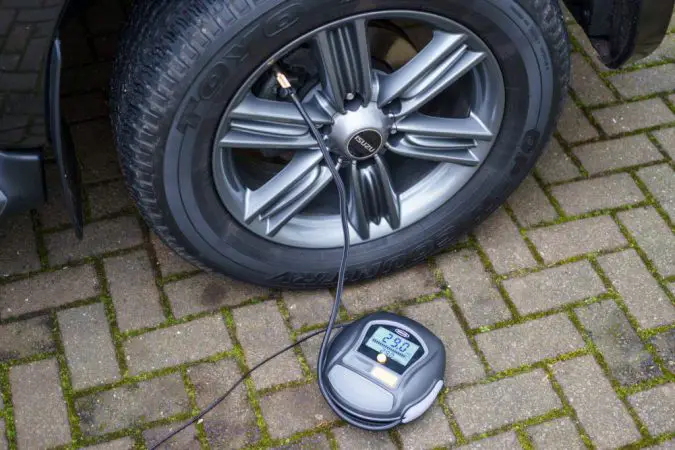
Critics, on the other hand, refer to evidence that demonstrates these benefits are minor. They also point out two significant drawbacks to employing nitrogen in tires:
- Nitrogen refills are difficult to come by. You can get nitrogen at some vehicle dealerships and tire shops, but you won’t be able to get it from your local gas station.
- The expense of a fillup or top-off can be high. Many nitrogen sources charge $5 or more per tire.
In the end, whether you utilize nitrogen or air in your vehicle’s tires is a personal preference.
If you want maximum performance, have access to nitrogen, and are prepared to monitor and maintain your tire pressure on a regular basis, using nitrogen may be worth the extra cost and effort. If not, you’ll be better off keeping your tires inflated.
How Can You Tell If Your Tires Have Nitrogen Mixed With Air?
The valve stem cap is the easiest way to check if a tire is filled with nitrogen. On nitrogen-filled tires, most dealerships and tire shops use green valve stem caps. This is a popular practice among nitrogen tire users.
However, this straightforward identification is not found on all nitrogen-filled tires. There is another way to determine whether your tires contain nitrogen or air. You may use a nitrogen purity tester to identify what’s in your tires because air contains only around 78 percent nitrogen.
- You can be assured that the tires are filled with nitrogen if the analyzer indicates 95 percent or greater.
- The tires are inflated with air if the reading is less than 80%.
- Your tires contain a mixture of nitrogen and air if the percentage is between 80% and 95%.
What Is The Lifespan Of Nitrogen Tires?
A car tire loses roughly 1.5 psi of air per month under normal conditions. Nitrogen molecules diffuse more slowly than oxygen molecules because they are bigger. The diffusion rate of nitrogen, in particular, is expected to be 1/3 to 2/3 that of regular air. As a result, nitrogen-filled tires lose around 0.5 to 1.0 psi per month.
Lower gas mileage, irregular tread wear, and slow handling occur when tires are deflated 1.5 psi or more below the manufacturer’s guideline. As your nitrogen tires deflate, it’s critical that you keep an eye on the pressure and top off the nitrogen on a regular basis.
Many owners assume that their nitrogen tires will stay adequately inflated between oil changes and don’t check them. Even nitrogen-filled tires lose 1.5 to 4.0 psi in the three to four months between oil changes, which is enough to cause the difficulties listed above.
How Frequently Should Nitrogen-Filled Tires Be Inspected?
Even though nitrogen-filled tires should last longer than air-filled tires, it’s still a good idea to check the tire pressure every month. If you let the tire pressure drop 1.5 psi or more below the manufacturer’s suggestion, you will lose all of the nitrogen tire benefits. A nitrogen fill will never be able to take the place of diligence and proper tire pressure management!
Can You Mix Air And Nitrogen In Tires – Pros & Cons of Nitrogen Tires
Now we’ll go over the benefits and drawbacks of nitrogen tires in greater depth.
Tires Filled With Nitrogen Stay Inflated For Longer
Nitrogen-filled tires, according to experts, stay inflated longer than tires filled with regular air. Because nitrogen molecules are bigger than air molecules, they do not seep out as quickly through the tire wall as air molecules do.
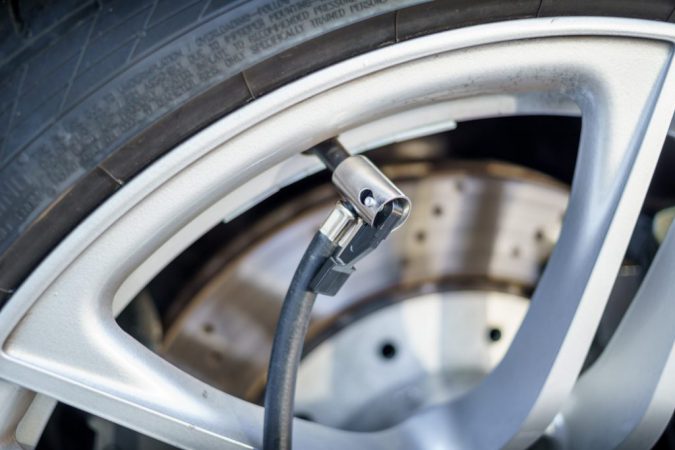
In fact, pure nitrogen seeps out of tires more slowly than air, according to research undertaken by the National Highway Traffic Safety Administration. The benefits of having your tires fully inflated include better fuel economy, easier handling, less even tread wear, and longer tire life.
Improved Fuel Economy
The recommended tire pressure for your vehicle can be found in the owner’s manual (just like the Tesla Model 3 tire pressure). The gas mileage of a vehicle is reduced when the tires are underinflated. Nitrogen-filled tires stay fully inflated longer and lose inflation more slowly than air-filled tires since nitrogen seeps out of the tires more slowly than air. This could help your vehicle run more efficiently.
Handling Is A Lot Easier Now
Tires that are properly inflated also help your car handle better. Under-inflated tires make your vehicle difficult to steer and turn. Unless you’re that car owner who routinely checks and tops off the tire pressure, the longer-lasting inflation of nitrogen could help your car’s handling.
Tread Wear Is More Even
Furthermore, the tread wears uniformly when you inflate your tires to the manufacturer’s suggested psi (pounds per square inch). Tires that are under-or over-inflated develop bald spots and weak sections over time. This not only diminishes their grip on the road but also puts them at risk of mishaps.
Longer Life Expectancy
Properly inflated tires survive longer than those that have been permitted to get underinflated.
Given that nitrogen filling keeps your tires at or near the manufacturer-recommended pressure for longer than air filling, you may save money in the long term by not having to replace your tires as frequently.
Nitrogen Improves The Quality Of The Ride
When it comes to maintaining pressure, nitrogen is more effective, as previously stated. As a result, you will have a lot better driving experience in this instance. The efficacy of the tires to absorb shocks and undulations improves when the tire pressure is within an optimal range. This results in an extremely pleasant ride, especially on highways and over long distances.
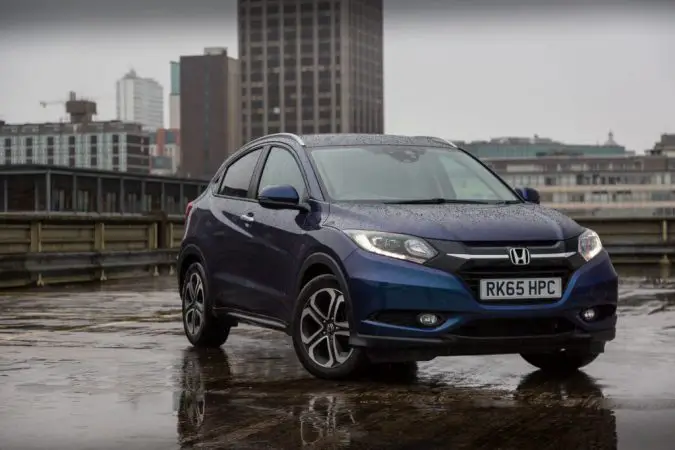
Water Is Introduced Into The Tires Via Compressed Air
Nitrogen supporters further point out that nitrogen does not introduce water into the tire, unlike compressed air. The ambient air composition is 78 percent nitrogen, 21% oxygen, and 1% additional gases. Water molecules are formed when small amounts of oxygen interact with hydrogen atoms. When you add air to your tires, these trace amounts of water settle in the compressed-air supply systems and are delivered into the tires.
Blowouts Are More Likely In Compressed Air
Moisture inside a vehicle’s tires can vaporize during high-temperature driving, boosting the overall temperature of the air inside the tires. The air pressure inside the tire rises when the temperature rises sufficiently. This can result in weak places and, in the worst-case scenario, tire blowouts.
Oxidation Of Tires
Moisture inside a tire can also promote oxidation, which causes the rubber to crack and become brittle. As a result, the tire’s lifespan is reduced. It also weakens the structure of the tire, making it more susceptible to failure during the performance.
They Are Environmentally Friendly
More than 300 million tires are dampened each year. It is possible to reduce the amount by 30% by using tires with nitrogen inflation. It also saves fuel, which helps to protect the environment. Carbon emissions will be reduced as a result. You will be helping to keep the environment green by doing so.
Damaging The Wheels
Internal tire moisture can cause oxidation in the metal wheel frame, in addition to causing damage to the rubber. This diminishes the wheel’s longevity and offers a potential safety issue if the wheel rusts through.
Reasons To Avoid Mixing Air With Nitrogen In Your Tires
Despite the increasing use of nitrogen in passenger vehicle tires, several experts warn that the benefits are not as great as they appear. They point out that nitrogen-filled tires lose air pressure just as quickly as air-filled tires. As a result, you must be attentive when it comes to checking tire pressure and topping off when it falls below the recommended level. Not only more difficult to get by than compressed air, but it is also more expensive.
Nitrogen Is Inadequately Available
Nitrogen refills are difficult to come by. Only available at a few petrol stations. Instead, you’ll have to take your car to a tire shop or a car dealership every time you need your tires refilled or topped off.
This normally necessitates making an appointment ahead of time or waiting until a technician is available. As a result, it’s far more inconvenient than simply inflating your tires, which you can do yourself at almost any gas station.
The Price Of Nitrogen Is Higher Than That Of Air
Nitrogen is also far more costly than air. Compressed air is available for free or a modest fee at many dealerships, tire shops, and petrol stations (typically $1.50 for enough air to fill all four tires). On the other hand, most nitrogen sources charge between $7 and $10 per tire for a nitrogen fill-up. This disparity adds up to significant additional costs over time.
Top-Up Stations Are Uncommon
There aren’t many nitrogen-filling stations around. If there is one, you will have to wait in line, especially on a busy day. If you fill the same tires with ordinary air, the nitrogen may be diluted. As a result, the benefits will be depleted.
Is Investing In Nitrogen-Filled Tires Worth It?
The fundamental advantage of nitrogen-filled tires is that they lose tire pressure more slowly than air-filled tires since the gas in the tire exits at a slower rate than air. The theory is that if you keep your tire pressure stable, you’ll get greater gas mileage and tire life because you’ll always be rolling on fully inflated tires.
It’s also claimed that nitrogen in tires minimizes tire “rot” by reducing the moisture that naturally occurs inside tires and preventing wheel corrosion caused by moisture contact. These assertions are exaggerated. The benefits of nitrogen-filled tires over regular air tires aren’t significant enough to warrant the cost or inconvenience.
The cost of new car tires can range anywhere from $70 to $179. You’ll spend up to $30 per tire for air to be drained and N2 to be refilled on existing tires. Refills will cost $5 to $7 per tire, and you’ll have to do them less frequently than with air-filled tires. However, you’ll need to top off every two or three months.
Is It Possible To Put Nitrogen In My Tires At Home?
Nitrogen can be added to your tires at home. Although this may cost you a lot of money upfront, it will save you money and time in the long term. You’ll need to get the following things:
- Valve core removal tool
- Lift jack
- Nitrogen and nitrogen container
- Inflator with digital gauge for tires
- Nitrogen purity analyzer
When filling your tires with nitrogen for the first time, follow these steps:
- Use a sturdy lift jack to secure the vehicle.
- The valve stem cap should be removed from the tire.
- Deflate the tire by removing the valve core.
- The valve core should be replaced.
- Connect the tire inflator’s line to the outflow valve on the nitrogen tank, and the nozzle to the valve stem of the tire.
- Open the valve on the nitrogen tank, fill the tire to 5 psi, and then close it.
- Remove the valve core once more to flush the remaining air from the tire.
- The valve core should be replaced.
- Fill the tire with nitrogen to the required pressure by the manufacturer.
- Disconnect the inflator from the valve stem of the tire.
- Connect the nozzle of the nitrogen analyzer to the valve stem of the tire.
- For a total of 25 seconds, leave the nitrogen analyzer attached.
- Repeat steps 3-12 if the analyzer reads less than 96 percent.
- Disconnect the analyzer from the valve stem when it detects 96 percent nitrogen or above.
- Reattach the valve stem to the tire inflator.
- Close the nitrogen tank’s valve after inflating the tire to the manufacturer’s specified pressure.
- Remove the tire inflator from the valve stem of the tire as well as the nitrogen tank.
- Replace the valve stem cap on the tire. To indicate that the tire is filled with nitrogen, replace the original black valve cap with a green one.
Facts: Can You Mix Nitrogen and Air in Tires
- It is safe to mix air and nitrogen in tires as there will be no adverse chemical reactions between the two gasses.
- Mixing nitrogen and air in tires is better than running on low pressure, which can damage tires and negatively impact fuel economy.
- Tires are designed to operate within a range of pressures, and proper tire pressure helps with fuel consumption, wheel alignment, wheel balance, and tire wear (you can learn more in our explainer on the tire pressure for Honda CRV).
- The air already contains nitrogen, and the only downside to mixing pure nitrogen with air is the loss of some performance benefits.
- Pure nitrogen maintains the right tire pressure better than normal air, as it permeates through the rubber at a slower rate, which maintains correct tire pressure for longer.
- Oxygen reacts negatively with rubber, and the water content in the air introduces the risk of corrosion on both steel and aluminum wheels.
- Proper tire pressure saves on fuel as improper tire pressure will result in decreased fuel economy due to tire roll or tire rolling resistance.
- Nitrogen is the perfect gas for race cars and aircraft because it maintains tire pressure better than air due to its thermodynamic qualities.
- To get nitrogen into tires, necessary equipment includes a nitrogen cylinder, lift jack, necessary tubes, hookups, and a digital tire inflator, among others.
- You can fill your tires with nitrogen for the first time at a dealership, tire center, or service station, and from then on you can refill your tires by yourself to save costs.
Final Verdict – Can You Mix Air And Nitrogen In Tires
Now that you’ve learned about the advantages and disadvantages of nitrogen tires, as well as whether you can fill them off with air in a pinch, you can decide whether nitrogen tires are right for you. Nitrogen inflation is probably more trouble than it’s worth for most drivers. Nitrogen tires, on the other hand, could be a great option for you if you’re serious about getting the most out of your car and willing to put in the time and money.
Nitrogen-filled tires can outperform non-nitrogen-filled tires. The only disadvantage is the high operational expenditures. If the fees aren’t a major concern, you can choose them as your tire of choice. So, Can you mix air and nitrogen in tires? The answer to that is yes. Overall, nitrogen-filled tires are the better option.

